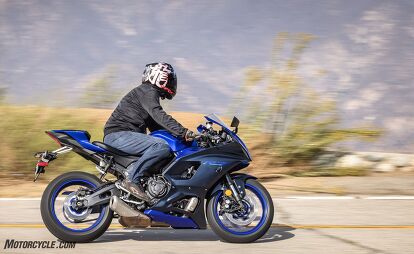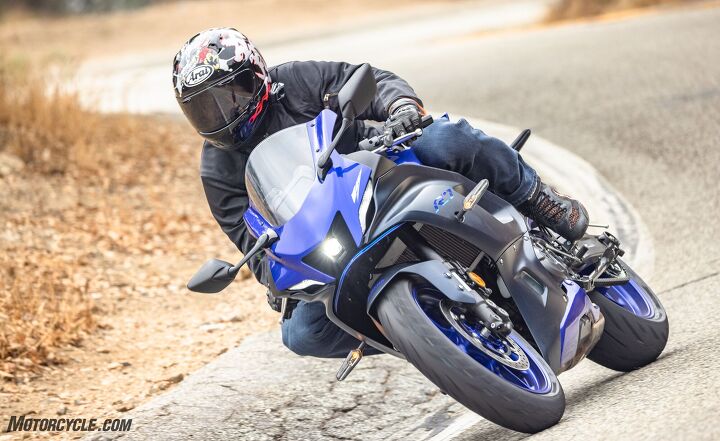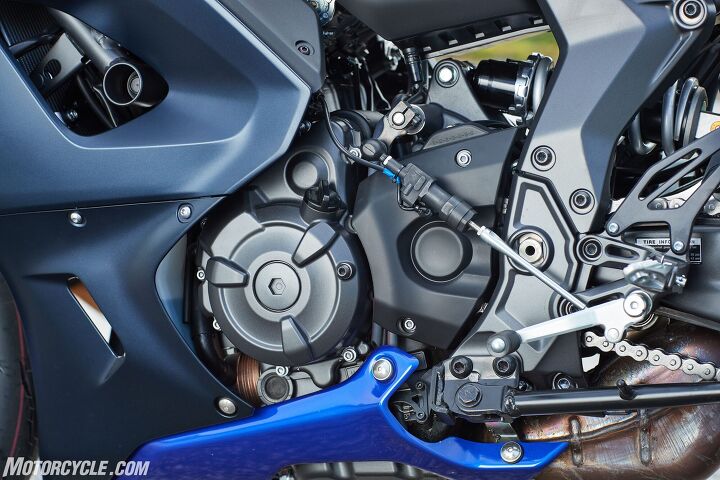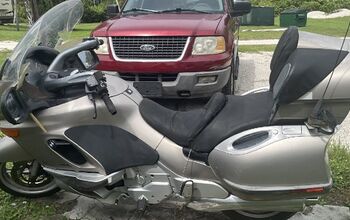What's The 2022 Yamaha R7 Like To Ride On The Street?

The R7 is a barrel of laughs on track, but is it any good on the roads?
I make it a point to tell everyone who is willing to listen (and even some who aren’t) how much fun the new Yamaha R7 is. While most people get up in arms about the name of the bike, I’m over here having a blast actually riding the thing, preferably at a race track. I said as much during my First Ride Review of the R7 back in May, too. What the R7 brings to the table in terms of elevating the MT-07 platform for track duty – all for under $9000 – is truly impressive.
2022 Yamaha R7
Editor Score: 85%
| Engine | 18/20 | Suspension | 12/15 | Transmission | 8/10 |
| Brakes | 7.5/10 | Instruments | 4/5 | Ergonomics | 7/10 |
| Appearance | 9.5/10 | Desirability | 9.5/10 | Value | 9.5/10 |
+ Highs
- An excellent learning tool
- Usable power for the street
- Great value
– Sighs
- The sportbike riding position gets old fast on the street
- Bars are a little narrow
- The (optional) quickshifter is a little clunky
No, its 689cc parallel-Twin isn’t super powerful, nor does it have top-class suspension or brakes. What it does have, though, is entirely adequate for learning the ropes. In my opinion, this is what makes it an excellent training tool for the sport or track rider who wants to learn proper technique instead of relying on horsepower. It demands smoothness, and when you don’t deliver, it communicates in ways other bikes, with their better components, will simply mask.
That’s all well and good, but for as fun as the R7 is on a track, we can’t forget that it still has lights, mirrors, turn indicators, and a license plate. It is a street-legal motorcycle, after all – which is exactly what the focus groups Yamaha consulted wanted. Considering we haven’t yet taken an R7 off the track and onto the roads, we decided this would be as good a time as any to do so. If we think back to the kind of motorcycle Yamaha built in the R7 based on focus group feedback, then we recall what’s essentially a “usable” R6. In other words, a sportbike in appearance and attributes but with an engine and powerband the average user can access on the street. In other words, an engine with midrange torque.
Here’s where we have a problem. If you know me, then you know how much I think Sportbikes are Terrible on the street. The low clip-ons that are great on track are torturous while cruising around. Maybe that’s my age talking since I know there are plenty of riders who disagree. They must be the ones who responded to Yamaha’s focus group invite. Anyway, aside from the clip-ons, the R7’s chassis changes (compared to the MT-07) are important enough to see just how well the little bike handles the roads. Click on the First Ride link above to learn more about those little changes, but in short, some slight geometry tweaks and a slightly more rigid chassis are the big differences between the MT-07 and R7.
Riding the R7 around town gets the kind of reaction out of me as you probably expect – it’s not very fun. The reason is exactly what I mentioned before: the clip-on bars. With them mounted below the triple clamps, it puts weight on your wrists and makes it a little difficult to keep a loose grip on the bars. Not to mention, after a while, the strain on your wrists gets annoying. For some, it could even be mildly painful. Clearly, this makes it less than optimal for freeway cruising. Then again, all you have to do is look at the R7 to realize its intent is sport and track riding. The R7 is not pretending to be something it’s not. It’s foolish of me to expect anything else.
With the acceptance of its intent firmly in place, we can look beyond the annoyance going on at the wrists. Here is where the R7’s selling points shine once again. The midrange power is located in a natural spot within the rpm range, which means you get up and go when you twist the throttle. At street speeds, the high-strung R6 would be about 5000 revs shy of its sweet spot (that’s an exaggeration, but not much of one). Not so with the R7. Sure it falls flat when the revs near redline, opposite of the R6, but who the heck is revving to the teens on the street anyway? The R7 is the definition of the streetable sportbike.
Get it up into the hills and you’ll really start to appreciate the streetable sportbike aspect even more. What we’ve liked about the R7 is its flickability and playful nature. All of these attributes come back to the fore once you find some twisty roads. Suddenly, the seating position that cramped the wrists on the freeway en route to the hills is now a benefit when it comes time to carve them up. It puts you in the attack stance, though I did find the narrow tank and subsequently narrow bars require a little more effort than I was expecting to sling side-to-side.
At street speeds, the available torque pulls you out of corners nicely, and even though the unit on our test bike was a little clunky at slower speeds, the $200 option for an up-only quickshifter is still one to go for. It really does make life a little easier. As was said before, the suspension, chassis, and brake components are not top-shelf, but they’re still very capable. And the point about being a great learning tool was brought home when I handed our off-road specialist Ryan Adams the key. He pointed out that, as he was setting up for a corner and trail braking, he could feel the suspension and chassis pitch progressively until they reached their lowest point. “Then that was my cue to release the brakes and get back on the throttle.” Smoothness is rewarded on the R7, and when done right, it’ll tell you what it’s doing.
Sport Riding, Distilled
The big takeaway here is that nothing revealed during this test should come as a surprise to anyone. The R7 is an unapologetic sportbike. One I can only imagine checks every box the focus groups Yamaha consulted with asked for. The styling is undeniable, and its usability in real-world environments is everything the R6 wasn’t.
Without any of the electronic rider aids practically all sportbikes are equipped with these days, the R7 is a throwback to the learning tools riders used before they could simply rely on TC. The meager suspension emphasizes smoothness, while the lack of high-end power forces the rider to maximize what they have. Without traction control, tire degradation and grip management will all be done by the rider – all important lessons to master before graduating to a full electronics suite.
Then again, if a racetrack is a place you’re never going to visit and you simply like the looks of the R7, it’s a simple and unassuming place to be – just as long as you prime your joints for the ride.
In Gear

Helmet: Arai Defiant-X Dragon
- Communicator: Cardo PackTalk BOLD JBL Headset
- Jacket: Alpinestars Oscar Bomber Jacket
- Airbag: Alpinestars Tech-Air 5
- Gloves: Alpinestars SP-2 v2 Gloves
- Pants: Alpinestars Diesel Shiro Riding Jeans
2022 YZF-R7 Specifications | |
|---|---|
| MSRP | $8,999 – Team Yamaha Blue – Available from June 2021 $8,999 – Performance Black – Available from June 2021 |
| Engine Type | 689cc liquid-cooled, 4-stroke, DOHC inline twin-cylinder; 4-valves per cylinder |
| Bore x Stroke | 80.0mm x 68.6mm |
| Compression Ratio | 11.5:1 |
| Fuel Delivery | Fuel injection |
| Transmission | 6-speed; multiplate wet clutch; with Assist & Slipper clutch |
| Final Drive | Chain |
| Front Suspension | Telescopic fork; 5.1-in travel, adjustable for preload, rebound and compression |
| Rear Suspension | Linked-type Monocross shock, adjustable preload and rebound; 5.1-in travel |
| Front Brake | Dual radial-mounted calipers, 298mm hydraulic disc, Brembo master cylinder |
| Rear Brake | 245mm hydraulic disc |
| Front Tire | 120/70ZR17 Bridgestone Battlax Hypersport S22F E |
| Rear Tires | 180/55ZR17 Bridgestone Battlax Hypersport S22R E |
| Length | 81.5 inches |
| Width | 27.8 inches |
| Height | 45.7 inches |
| Seat Height | 32.9 inches |
| Wheelbase | 54.9 inches |
| Rake (Caster Angle) | 23°40′ |
| Trail | 3.5 inches |
| Minimum Ground Clearance | 5.3 inches |
| Fuel Capacity | 3.4 gal |
| Fuel Economy | 58 mpg (claimed) |
| Wet Weight | 414 pounds (claimed) |
| Warranty | 1 Year (Limited Factory Warranty) |
We are committed to finding, researching, and recommending the best products. We earn commissions from purchases you make using the retail links in our product reviews. Learn more about how this works.
Become a Motorcycle.com insider. Get the latest motorcycle news first by subscribing to our newsletter here.

Troy's been riding motorcycles and writing about them since 2006, getting his start at Rider Magazine. From there, he moved to Sport Rider Magazine before finally landing at Motorcycle.com in 2011. A lifelong gearhead who didn't fully immerse himself in motorcycles until his teenage years, Troy's interests have always been in technology, performance, and going fast. Naturally, racing was the perfect avenue to combine all three. Troy has been racing nearly as long as he's been riding and has competed at the AMA national level. He's also won multiple club races throughout the country, culminating in a Utah Sport Bike Association championship in 2011. He has been invited as a guest instructor for the Yamaha Champions Riding School, and when he's not out riding, he's either wrenching on bikes or watching MotoGP.
More by Troy Siahaan





















































Comments
Join the conversation
In my 20s and 30s I regularly did 500-700 mile days on a CBR600F4i, CBR600RR, and Buell 1125R, including a few 3k+ mile trips. Barely and of that was hwy, most was WV, TN, and GA twisty backroads where a sport bike was right at home.
Now in my 40s, I can appreciate a those same roads on a sport naked, or ST.
How tall is the reviewer? The footpegs look low and uncramped.